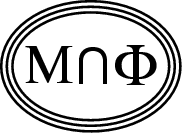
Back to
OP page
Combined
List
List by
Contributors
 Back to OP page Combined List List by Contributors |
OPTIMAL FLUX FOR THE QUARTER-FILLED BANDContributed by: Elliott H. Lieb (Princeton Univ.), Sept. 15, 1998.
Abstract
The well known diamagnetic inequality states that the
application of a magnetic field to the orbital motion of an electron
raises the electron's energy. When many electrons are present, however,
the Pauli exclusion principle can cause a lowering of the energy.
Indeed, it has been conjectured by several authors (cf. [1]
for references) that this is
so for a lattice model of independent electrons (the Hueckel model) and
that the magnetic flux that gives the lowest energy is 2\pi times the
electron density. This was proved in the above paper for the half-filled
band (density = 1/2), even with an on-site interaction among the
electrons (Hubbard model).
|